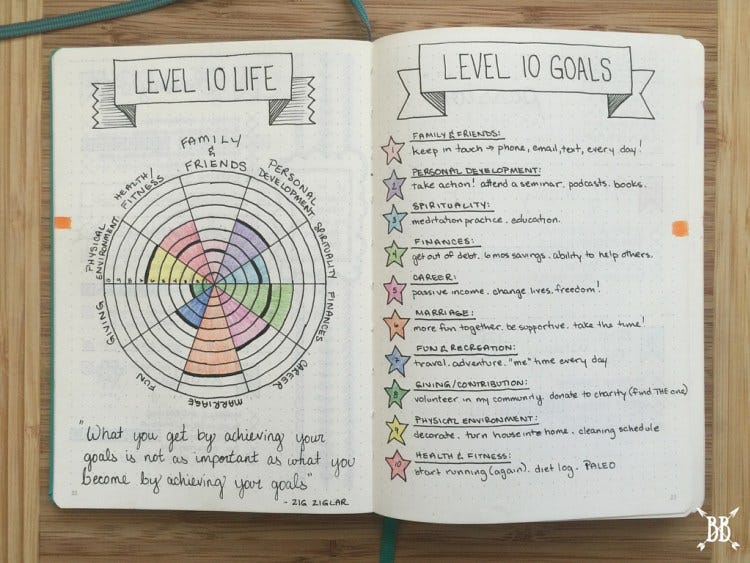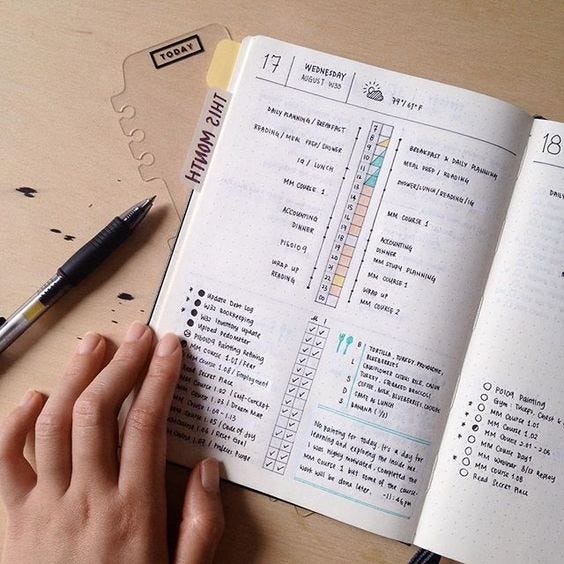plan personal ideal year
src: How to Plan Your Ideal Year - 2017-12-20
Abstract
TL;DR: My process consists of the following:
- Create a vision document: I imagine myself in a year and write down everything that I would like to happen. This allows me to visualize the future. I write this in the present tense.
- Write down my goals: This is a short list that reminds me of my top priorities across my top life categories.
- Measure quarterly/monthly/weekly/daily progress:
- Quarterly — Update vision document and wheel of life
- Monthly — Retrospective
- Weekly — Review annual goals, monthly priorities, and write weekly priorities (3 personal/3 professional)
- Daily — 3 Priorities
“Five days a week, I read my goals before I go to sleep and when I wake up. There are 10 goals around health, family, business, etc., with expiration dates, and I update them every 6 months.” — Daymond John, Founder and CEO of FUBU
During the last week of December, I take a few days to reflect on the previous year and plan goals for the upcoming year. This year, I achieved all of my goals by making daily, weekly, and monthly progress on them.
I started to do this as I didn’t have an ideal year… That year, I realized that I didn’t have a work-life balance across my health, relationships, financials and other important area. So I set goals for the areas in my life I wanted to improve, and planned my year accordingly.
At the onset of the following year, I tried to plan, hoping to achieve more. If I can accomplish in one year, what might usually take three years, why not take that route? It would require discipline, prioritization and commitment to make those goals happen.
That year worked out beautifully, so I doubled down on goal setting. Over the years, I’ve optimized my planning process to do the minimal amount to get the maximum desired output. It’s enabled me to lead Skillshare, develop new habits, and maintain an active healthy and social life.
How Do I Do This?
TL;DR: My process consists of the following:
- **Create a vision document
**I imagine myself in a year and write down everything that I would like to happen. This allows me to visualize the future. I write this in the present tense. - Write down my goals
This is a short list that reminds me of my top priorities across my top life categories. - Measure quarterly/monthly/weekly/daily progress
- Quarterly — Update vision document and wheel of life
- Monthly — Retrospective
- Weekly — Review annual goals, monthly priorities, and write weekly priorities (3 personal/3 professional)
- Daily — 3 Priorities
I’d like to expand on how I use each of these tools or processes:
How I Create My Vision Document
I usually have a theme for the year that inspires me. An example of a theme — “be the chef” to always be inventing, which was inspired by this Wait But Why article on Elon Musk.

noma — previously one of the top restaurants in the world
After I select a theme, I select an image that reminds me of that year’s theme. If the theme was around “being the chef”, I would select an image of a chef or restaurant. This image reminds me to invent, to be creative, and to work hard every single day.
Beneath that, I write down my 10 goals for the year, followed by a written vision document of what I would like to accomplish that year. I write that document in the present tense with very clear, concise language.
This vision document is short, no more than a few pages. The goal is to really visualize where you would like to be in a year. I quickly scan and read through this document every month.
How I Set Goals
I create a wheel of life based on my major life buckets. Here’s an example that I found on Pinterest:

Source: BohoBerry
I have a list of 10 buckets but you can plan for any number and any life bucket. The goal here is prioritize the important “life buckets” for you. Here’s an example of some of my life buckets:
- Work
- Relationship
- Health
- Financials
- Family / Friends
- Creativity
- Leadership
- Content
From there, I write down a goal for each one of these life buckets. It’s important to note that you want these goals to be SMART goals (specific, measurable, achievable, results-focused, and time-bound). Your goals should be tied to a desired outcome.
Here’s an example:
- Content — Reach 100K views on Medium
As you can see, you can list anything! Different people can juggle different numbers of goals, and I found my sweet spot. From there, I rank myself on a scale of one to ten within each life bucket — where I am right now (i.e. end of previous year). By doing this, it gives me a pulse check of where I am and I can brainstorm ideas on what I can do over the next three months to improve my score. I do this every quarter.
I typically try to set an ambitious goal that is slightly uncomfortable. Anything too easy isn’t challenging. Anything overly ambitious is unrealistic and unmotivating. Picking the right goal, just a little beyond something you believe you can attain, is the key to motivating yourself.
Once you start hitting those goals, it’ll start building momentum, which allows you to reset those goals higher and higher.
The Review Process Is Key
The secret sauce is in the process of writing down your goals, reviewing them constantly, and making incremental progress on them. This process combined with visualizing the end goal will make those goals happen.
There are some months where I do everything listed below. Other months where I might skip a step here or there. But, I almost never skip the weekly planning session.
Quarterly Reviews
I like to spend these quarterly reviews zooming out and getting a high level perspective on how I’m doing. Sometimes, I’ll do these quarterly reviews during my Think Week, or in a quiet place.
- Update vision document — make any edits that bring your vision to life. What does success look like?
- Update wheel of life — re-rank yourself across your major life buckets. Where are you scoring low? Where are you scoring high? Where do you need to readjust?
I typically carve out half of a day for my quarterly reviews.
Monthly Retrospective
Schedule these out in advance, and make sure you execute on them. You’ll feel tempted to skip these in favor of something more urgent or fun… Don’t!
- From 0–10, how do you feel you are doing?
- What were the highlights and lowlights?
- What were the biggest lessons learned?
- Review your goals and assess your progress. Did you spend your time on the right things? If not how will you improve next month?
- Write down goals for the upcoming month.
I do this on the last day of every month. It usually takes an hour or two.
Weekly Planning
Every week, I review my annual goals, and review the action steps to make progress on those goals.
- Review annual & monthly goals
- Review last week’s progress
- Review habits
- Plan weekly priorities (3 personal & 3 work)
I do my weekly planning on Monday morning at 9am. It usually doesn’t take more than 60 minutes.
Daily
Every morning, I write down my top 3 priorities that I need to accomplish that day. Sometimes, I hit them and sometimes I don’t but the process of prioritizing is important. If I have time, I’ll also brainstorm any additional ideas to clear my mind.

Credit: @penpapersoul
From there, I time-block my day (similar to what I mention in my Ideal Week article). This allows me to proactively put time in my calendar to make progress, instead of being reactive with my calendar.
This check-in takes me a few minutes to do every morning.
Create, or Cut, Habits
If you want to take your year to the next level, try to add a new habit every month. Ideally, these habits should be related to your goals in some way, or one of the areas of your life you want to improve. Some of the habits that I developed throughout 2017:
- Cut out soda
- Cut out coffee
- Meditate a few times a week
- Ask more questions
We unconsciously pick up habits in the background and we keep them for decades, said Naval Ravikant in an interview with the Knowledge Project:
“I think human beings are entirely creatures of habit. Young children are born with no habit loops. They’re essentially born as blank slates. Then they habituate themselves to things and they learn patterns and they get conditioned and they use that to get through everyday life. Habits are good. Habits can allow you to background process certain things so that your neocortex, your frontal lobe, stays available to solve brand new problems.”
Your life is collection of habits you develop over a lifetime. I believe it’s possible to rewire and create new habit loops. Research shows that it takes 66 days for a new behavior to become automatic.
Source: James Clear
Over time, if you add one new habit a month, that’ll ladder up to 12 new habits in a year, which will accumulate to 120 new habits over a decade. It’s hard work but these small incremental changes will change your life.
I recommend tracking your habits daily with an app like HabitBull.
Some other things to note throughout the process:
- Planning your year takes a lot of dedication and is an incremental progress. Reviewing and re-planning is crucial to executing well. None of it happens overnight.
- Celebrate your wins! For example, treat yourself to a special dinner when you hit your goals.
- It’s very important to manage your energy. If some projects are like pulling teeth, it’s OK to pause and to make progress on other goals.
This is a process that I created for myself. There are components that won’t be ideal for everyone.
But if you can create a process that works for you and stick with it, I’m confident you will have an exciting, fulfilling, and very successful coming year!